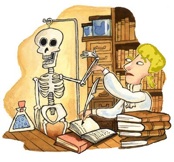A National Science Foundation Research Experiences for Undergraduates Site
Department of Anthropology, University of Notre Dame, Notre Dame, IN 46556
.



The links below will take you to the Bab edh Dhra research, as well as projects associated with the previous NSF-REU studies (Byzantine St. Stephen’s collection):
-
✦2011 Projects
-
Archaeological Chemistry @ Bab edh-Dhra’
-
Poor collagen yields were obtained from Bab edh-Dhra’ femora cortical bone, decreasing the potential for stable carbon (C) and nitrogen (N) isotope analysis. However, preservation of stable strontium (Sr) was found in the dental enamel of a 20 adult teeth. This summer’s research will therefore focus on the potential of bone chemistry for reconstructing aspects of diet and population mobility using teeth. In addition, other bone samples will be tested.
-
Burned Bone/Taphonomy of Bab edh-Dhra’
-
Many of the bones from the A22 charnel house at Bab edh-Dhra’ show evidence of burning, believed to be the result of a fire that swept the enclosure after use of the facility had ceased. Extensive burning throughout the structure, including probable roof beams, as well as linen near the doorway thought to be an incendiary device, were excavated. While this charnel house is a major feature of the site, there had been no systematic study of the burning or other taphonomic processes prior to these projects.
-
Childhood Health & Adaptability @ Bab edh-Dhra’
-
This summer focused on developing a demographic profile of the considerable subadult remains from charnel house A22.
-
Daily Activies @ Bab edh-Dhra’
-
Indicators of "occupational stress" were addressed throughout the body, particularly in relation to agricultural activities. Student teams focused on various regions of the skeleton to assess individual markers of activity, as well as functional muscle groupings.
-
Paleopathology @ Bab edh-Dhra’
-
Increased population density has been associated with a marked rise in disease stress worldwide. At Bab edh-Dhra’ this was likely compounded by diminishing nutritional quality associated with subsistence changes. Furthermore, one theory for the presence of a fortification wall surrounding the community is an increase in interpersonal conflict. A preliminary survey of the remains shows considerable nutritional stress as well as a high degree of trauma in the EB II-IV individuals. This stands in sharp contrast to patterns seen in the EB I, prior to settled village life and the construction of a wall.
-
Paleopathology @ Byzantine St. Stephen’s
-
Age-related changes in bone maintenance, effects of nutritional inadequacy, and traumatic interaction provide monitors of adaptation among the adult segments of a society. Adults are the primary food-getters, nurturers, and the individuals responsible for establishing the cultural buffers that permit their society's adaptation; analysis of their well-being is of paramount importance to a complete biocultural reconstruction of the community.
-
Migration/Pilgrimage - Byzantine St. Stephen’s
-
According to the literature, pilgrimage to holy sites was a major cultural phenomenon that saw its zenith during the 5th-7th centuries in Jerusalem. Recently however, scholars have begun to question the validity of these reports, stating that the pilgrimage accounts so prevalent for this period in fact reflect the writings of an elite minority. By studying the genetic evidence for relatedness frozen in the skeletal and dental remains, in conjunction with the historical accounts, the focus of this summer was to understand the diversity of people represented by the large monastic community at St. Stephen’s.
-
Diet Reconstruction @ Byzantine St. Stephen’s
-
The St. Stephen’s collection provides a natural ‘control group’ to study dietary practice -- the regimented daily activity patterns so clearly documented in the literature provide the mechanism by which to frame testable hypotheses related to Byzantine subsistence in a monastic setting.
-
Daily Activity Patterns @ Byzantine St. Stephen’s
-
While skeletal records allow us to determine the effects of long-term ascetical practices on the bodies of the St. Stephen’s monks, cultural and textual studies provide a means to differentialy diagnose the cause of skeletal features, while also enhancing our understanding of their gestures.
-
Subadult Demographics @ Byzantine St. Stephen’s
-
Childhood is the ‘bottleneck’ of natural selection; therefore, a group’s ability to supply the biocultural means for subadult survival provides a monitor of adaptive success. The most surprising find associated with the St. Stephen’s collection were the large number of subadults. This summer focused on developing a fuller understanding of their presence in a monastic tomb to glimpse possible adaptive mechanisms for child-rearing in Byzantine society, and the role of the early church in this cultural context.
Research projects in action...
Students work in teams to facilitate collaborative research skills, and provide an internal check on accuracy of data collection. They will research the topic together, learn and apply statistical methods jointly, compile and survey the pertinent literature in combination, and present the results of their findings together.
.
2012 - Clark Spencer Larsen, Ph.D., Ohio State University
2011 - Kelly Knudson, Ph.D.; Arizona State University
2010 - Christopher Schmidt, Ph.D.; Univ. of Indianapolis
2009 - Brenda Baker, Ph.D.; Arizona State University
2008 - Clark Spencer Larsen, Ph.D.; Ohio State University
2007 - Donald Ortner, Ph.D.; Smithsonian Institution
2006 - Donald Ortner, Ph.D.; Smithsonian Institution
2005 - Clark Spencer Larsen, Ph.D.; Ohio State University
2004 - Mark Schurr, Ph.D.; University of Notre Dame
2003 - Mary Lucas Powell, Ph.D.; University of Kentucky
2002 - Dennis Van Gerven, Ph.D.; University of Colorado


The ‘skeleton action figure’ above is modified from: www.jeffshelly.com/images/educationimages/skull.jpg








